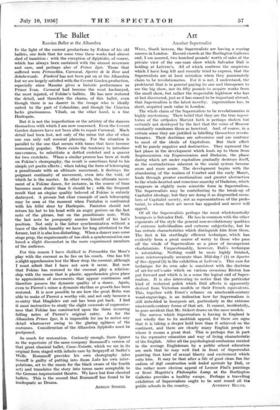Art
Another Superrealist WELL, thank heaven, the Superrealists are having a roaring success in London. Record crowds at the Burlington Galleries and, I am assured, two hundred pounds' worth of sales at the private view of the one-man show which Salvador Dali is holding at Lefevres. All of which confirms the suspicions which I have long felt and recently tried to express, that the Superrealists are at least mistaken when they passionately claim to be revolutionaries. For it is not, I understand, the proletariat that is in general paying its one and threepence to see the big show, nor its fifty pounds to acquire works from the small show, but rather the respectable highbrow who has at last discovered, just as it has ceased to be important abroad, that Superrealism is the latest novelty. Superrealism has, in short, acquired snob value in London.
The whole claim of the Superrealists to be revolutionaries is highly mysterious Marxist faith is perhaps shaken but Their belief that they are the true reposi- tories of the orthodox
not dest yed by the fact that the voice of Moscow
io
constantly condemns them as heretical. And, of course, in a certain sense they are justified in labelling themselves revolu- tionaries. Their doctrines are subversive and are contrary to most of the ideals of Capitalism. But their effect will be purely negative and destructive. They represent the last phase in the development which leads up to them from Impressionism via Expressionism and Dadaism, the phase during which art under capitalism gradually destroys itself, as the contradictions inherent in the social system become more and more acute. The development begins with the abandoning of the realism of Courbet and the early Menet, leads through greater emotionalism and greater abstraction to the whole-hearted and conscious anarchy of Dadaism, which reappears in slightly more scientific form in Superrealism. The Superrealists may be contributing to the break-up of Capitalist ideology, but they are doing it as disgruntled mem- bers of Capitalist society, not as representatives of the prole- tariat, to whom their art never has appealed and never will appeal.
Of all the Superrealists perhaps the most wholeheartedly bourgeois is Salvador Dali. He has in common with the other exponents of the style the general non-revolutionary qualities of extreme individualism and extreme subjectivity, but he has certain characteristics which distinguish him from them. The first is his startlingly efficient technique, which has evidently been a great source of worry to those who pass off the whole of Superrealism as a piece of incompetent charlatanism. Unquestionably, however, Dali's technique is astonishing. Nothing could be more highly finished, more microscopically accurate than Mid-day ? (1) or Spectre of Sex-Appeal (3) in the exhibition at Lefevre's. This care for technique for its own sake is consistent with the doctrine of art-for-art's-sake which on various occasions Breton has put forward and which is in a sense the logical end of Super- realism. It is also interesting to notice that the particular kind of technical polish which Deli affects is apparently derived from Victorian models or their French equivalents. This, together with Ernst's reliance on nineteenth-century wood-engravings, is an indication how far Superrealism is still imbedded in bourgeois art, particularly in the extreme nineteenth-century forms of that art. It cannot, incidentally, be pure accident that Mr. Sickert draws on the same models.
The success which Superrealism is having in England is not wholly due to its snobbish appeal, for there are signs that it is taking a deeper hold here than it achieved on the continent, and there are clearly many English people to whom it means a great deal. This is perhaps due in part to the repressive education and way of living characteristic of the English. After all the psychological confusions created in the average Englishman by a public school education are such that he may well find in front of Superrealist painting that kind of sexual liberty and excitement which suits him. It may be that after a life of good clean fun the sadism of Soft construction with boiled apricots by Dali, or the rather more obvious appeal of Leonor Fini's paintings or Rene Magritte's Philosophic Lamp at the Burlington Galleries provides a healthy escape. Perhaps a travelling exhibition of Superrealism ought to be sent round all the public schools in the country. ANTHONY BLuxr.










































 Previous page
Previous page